You’ve probably never heard of Somlói galuska, and yet it is one of the Magyars’ favorite desserts. For some unfathomable reason, it doesn’t even appear on the menu at André’s Café. The name translates as “Somló dumpling” in English, Somló being a town near Lake Balaton, famous (moderately) for its hill and its wine. Calling it a dumpling is a tad misleading, as what we’re really talking about starts as a trifle-like cake made of several layers of sponge, custard, and raisins, and is then scooped into balls and served with whipped cream.
The Somlói galuska (shall we call it SG?) was invented in the late 1950s by Károly Gollerits, long-time head waiter at the famous Gundel restaurant in Budapest. If you think about it for a minute, this hardly sounds like a guarantee of quality. Gundel in the ’50s had fallen victim to nationalization, the quality of the food sharply declining against a backdrop of sociopolitical repression, economic turmoil, and plummeting standards of living. Also, correct me if I’m wrong, but dishes are generally created not by the front of the house, but by the back (you know, the people who actually learned how to cook). So far, this all seems more like the ultimate shortcut taken by an aging waiter, pushing the boundaries of communism’s sloppiness by dumping lumps of cake onto a plate instead of bothering to cut normal slices…
Not so fast! It turns out star waiter Gollerits merely imagined the dessert. The execution was handled by pastry chef József Béla Szőcs, who, before coming to Gundel, trained at the equally famous Patisserie Gerbeaud. Szőcs decided to name the creation after the place he came from, where he apparently operated his own pastry shop as well — the Somlyó hill in Fót, on the outskirts of Budapest, a hill that’s technically too small to really be called such, and which was declared a nature preserve to protect its 1,500 species of butterflies. That’s Somlyó with a Y in it.
The dwarf hill of Somlyó had nothing to do with the more legit hill of Somló, until Brussels decided otherwise. At the Brussels World Fair of 1958, SG was served at the Hungarian pavilion. Legend has it that at some point there, the name was misspelled, and Somlyói galuska became known as Somlói galuska, advantageously trading the obscure hummock for its viniferous near-homonym.

A typical SG is nothing simple, which voids any suspicion of sloppiness. It contains three different sponge cakes: plain, chocolate, and walnut. The sponges are arranged into layers, alternating with pastry cream and raisins soaked in rum. Then you grab your scooper, and serve three scoops (always three: Christian country –> Holy Trinity –> three of everything, I suppose), garnished with your favorite toppings.
There are many places where one can try SG in its natural habitat (Hungary, that is). In Budapest, for the two entirely opposite ends of the spectrum, head to Gundel for a take on the original Somló Sponge Cake à la Gollerits, or to Onyx for the more modernist Somló 21st Century.


I haven’t been to Budapest for over ten years, unfortunately, but I did have the opportunity to try SG in a couple places during a recent trip to Sopron. The Erhardt Restaurant and Pension is where I had my first SG ever. Erhardt delivers a solid execution of the classic recipe: three scoops topped with a mound of whipped cream, chopped walnuts, and chocolate sauce, though I can’t tell if there are really three different sponges or only two. This in fact encapsulates my first impression of SG: a quite unusual dessert where it’s pretty hard to identify all the elements and flavors. The pastry chef at Erhardt is quite scooper-happy and also serves the chocolate mousse in scoops (this isn’t unique, but you’ll see later that it got me thinking).


Out from the center of town, the Harrer Chocolate Factory isn’t just a chocolate factory that offers guided tastings (although that’s certainly the main draw), it also hosts a café serving a variety of pastries. There seems to be a trend to serve Somlói as a cake rather than dumplings, and that’s how it’s done at Harrer. The layers are clearly apparent, which certainly helps me figure out what I’m eating. From bottom to top, the layers are: boozy chocolate sponge, pastry cream, walnut sponge, pastry cream, plain sponge, macerated raisins, and cocoa powder. It tastes very good, probably better than Erhardt’s, but conceptually, the cake approach feels more like a step back than a step forward.
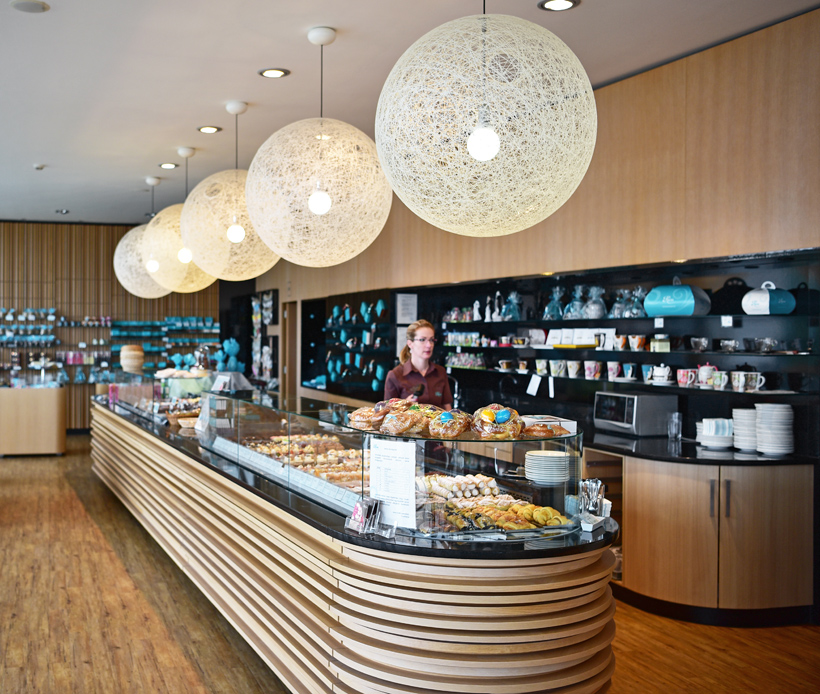

And that’s the thing about SG. The pairings are very classic — even tired, you might rightfully say: chocolate, walnuts, raisins… However, for me, the appeal lies elsewhere. The SG is a rare example of a plated dessert, not just a slice of cake served à la mode, or a crêpe that obviously couldn’t be eaten if it wasn’t served on a plate, or a couple of ice cream scoops in a bowl. The SG is something that starts as a bona fide cake — a rather complicated one — and is deliberately turned into something else.
So I’ve tried to tackle the issue of the boring flavors pairings, while still preserving the quintessential scoops of the original Somló dumpling:
- First, I’m separating some of the flavors — if we have to serve three scoops, why not make them each different? There’s one scoop with chocolate sponge, and one with walnut sponge. This implies preparing two simpler cakes instead of one complex one. No plain sponge; I have other plans.
- Plain pastry cream is boring, so I’m flavoring mine with apricot. I’ve seen SG recipes on the web that use apricots as a garnish, or apricot preserves between some of the layers. Here the apricot is right inside the cream. It takes a hell of a lot of apricot preserves to make the fruit flavor come forward in the final dish, so I’ve ended up boosting it with freeze-dried apricot powder.
- We also don’t need to have pastry cream everywhere, so I’m replacing some of it with chocolate mousse, mixed with rum-soaked raisins. This also adds some textural variety.
- My third dumpling is actually a scoop of ice cream, again for texture contrast — and temperature contrast too. To stick to the apricot/nut theme, I’ve made a batch of my apricot kernel ice cream. The flavor works great, but should I ever make this whole dessert again, I would look into adding the Hungarian equivalent of cookie dough to the ice cream. With dough, I can really call it a dumpling (sort of)!
- I top my SG with apricot brandy whipped cream and chocolate-covered walnuts. These are the same flavors that are being repeated throughout the dessert elements, but never all muddled together, so you don’t have to wonder what the hell you’re eating.
This is definitely a lot of work, but each element isn’t that hard to make in itself and can be prepared ahead of time. One quick note about the egg amounts: I’ve measured the eggs in grams for better accuracy. If you’re wondering how many eggs you need, one large egg without the shell weighs about 50 g (15 g yolk and 35 g white).
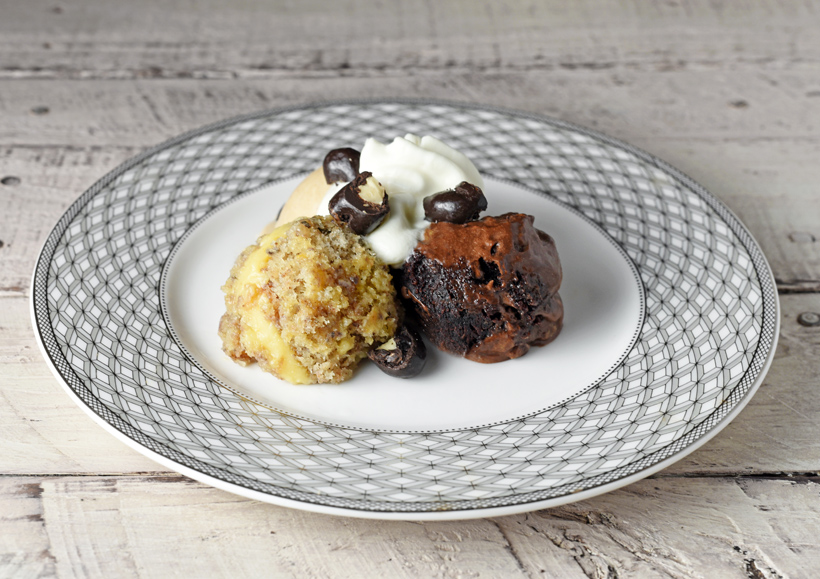
Walnut sponge
Yields about 10 servings
50 g AP flour
35 g walnut meal
pinch of salt
155 g egg, room temperature
80 g sugar
- Combine the flour, walnut meal, and salt.
- In a stand mixer fit with the whisk attachment, mix the eggs and sugar on high speed for about 3 minutes, until tripled in volume.
- Using a rubber spatula, fold in the walnut-flour mixture in 3 additions.
- Spread the batter onto a 33 cm x 23 cm baking pan lined with greased parchment paper. Bake in a 175 C / 350 F oven until the center springs back when pressed lightly, about 12-14 minutes. Let cool.
Apricot-rum syrup
Yields about 10 servings (230 g)
120 g apricot preserves
90 g water
45 g dark rum
- Heat the apricot preserves and water in a saucepan over medium heat. Cook until the preserves have fully dissolved, stirring regularly.
- Transfer to a blender, and add the rum. Blend until homogeneous, then reserve in a plastic container.
Apricot pastry cream
Yields about 10 servings
70 g egg yolks
25 g sugar
30 g AP flour
350 g milk
175 g apricot preserves
- In a bowl, whisk the yolks and sugar to a ribbon, then mix in the flour.
- Bring the milk to a simmer in a small saucepan, then transfer to a blender, add the apricot preserves, and blend until homogeneous; don’t worry if the milk curdles a little.
- Return the apricot-milk mixture to the saucepan, and bring to boil. Add to the yolk mixture in several additions, to temper. Return the resulting cream to the saucepan, bring back to a boil on medium low heat, and boil gently for 2 minutes, stirring constantly (although you have to stop stirring for a second when checking if the cream is boiling/bubbling).
- Transfer to a plastic container, and cool in a bowl of ice water. When the cream thickens, start assembling the apricot-walnut cake below.
Apricot-walnut cake
Yields about 10 servings
walnut sponge
apricot-rum syrup
apricot pastry cream
12 g freeze-dried apricot powder
- Unmold the walnut sponge (if it’s stuck to the parchment paper, use a boning or fish knife to separate), and cut into three 11 cm x 23 cm rectangles.
- Line a 23 cm x 11 cm rectangular baking mold (at least 7 cm tall) with plastic wrap. Place one piece of sponge in the mold, and coat with 1/3 of the apricot-rum syrup. Top with 1/2 of the apricot pastry cream, then sprinkle 1/2 of the apricot powder using a sugar shaker.
- Repeat once: another piece of sponge, 1/3 of the syrup, 1/2 of the pastry cream, 1/2 of the apricot powder.
- Top with the remaining piece of sponge and the rest of the syrup.
- Cover with plastic wrap, and refrigerate for at least 6 hours. The cake can be prepared one day ahead.
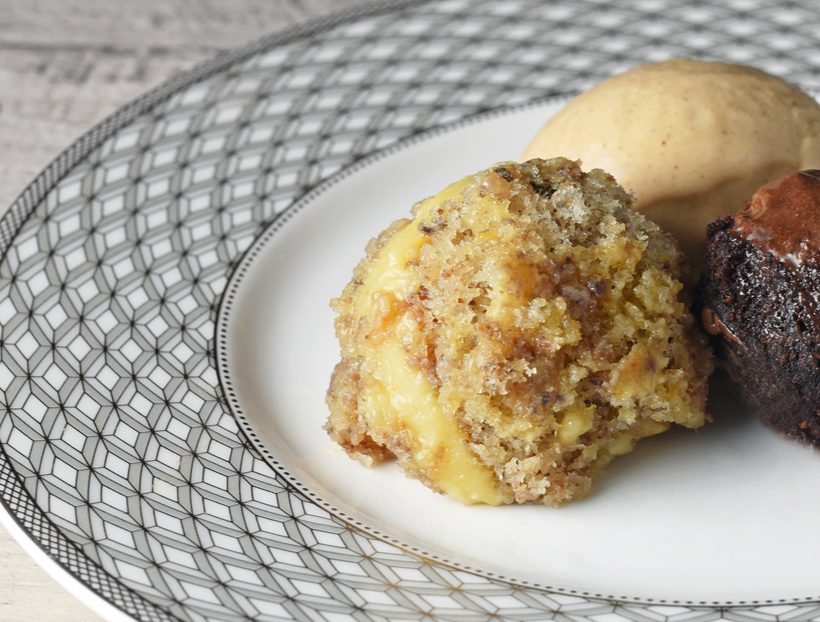
Chocolate sponge
Yields about 10 servings
150 g sugar
2.5 g salt
25 g Dutch process cocoa powder
75 g butter, melted
50 g flour, sifted
2 g baking powder
50 g egg yolk
55 g egg
- Combine the sugar, salt, and cocoa powder, and transfer to the bowl of an electric mixer fit with the whisk attachment. Add the melted butter, and beat on low speed for 10 seconds. Still on low speed, mix in the flour and baking powder first, then the egg yolk and egg. The batter should seem on the thin side for a cake.
- Pour the batter into a 23 cm x 11 cm cake pan lined with greased parchment paper. Bake in a 175 C / 350 F oven for about 22 minutes, until the center feels springy to the touch. Let cool.
Chocolate-raisin mousse
Yields about 10 servings
90 g golden raisins
35 g dark rum
30 g water
75 g heavy cream
150 g 64% dark chocolate, cut into chunks
70 g egg yolks
30 g superfine sugar
130 g egg whites
- Place the raisins, rum, and water in a plastic container, and microwave for 1 minute. Let soak for 1 hour.
- Place the heavy cream and chocolate in a plastic container, and microwave for 1 minute. Stir until the chocolate has melted.
- In a large bowl, whisk the egg yolks with the sugar until foamy. Slowly stir in the chocolate mixture with a rubber spatula. Let cool, and refrigerate for 20 min.
- Add the drained raisins to the chocolate mixture.
- Whisk the egg whites to soft peaks, then fold into the chocolate mixture until perfectly homogeneous — nobody wants white lumps in their chocolate mousse! Refrigerate for at least 1 hour.
Chocolate-raisin cake
Yields about 10 servings
chocolate sponge
chocolate-raisin mousse
- Unmold the chocolate sponge, and cut into two layers.
- Line a 23 cm x 11 cm rectangular baking mold (at least 7 cm tall) with plastic wrap.
- Place one piece of sponge in the mold, then cover with 1/2 of the chocolate-raisin mousse.
- Repeat: remaining sponge, remaining mousse.
- Cover with plastic wrap, and refrigerate for at least 6 hours.
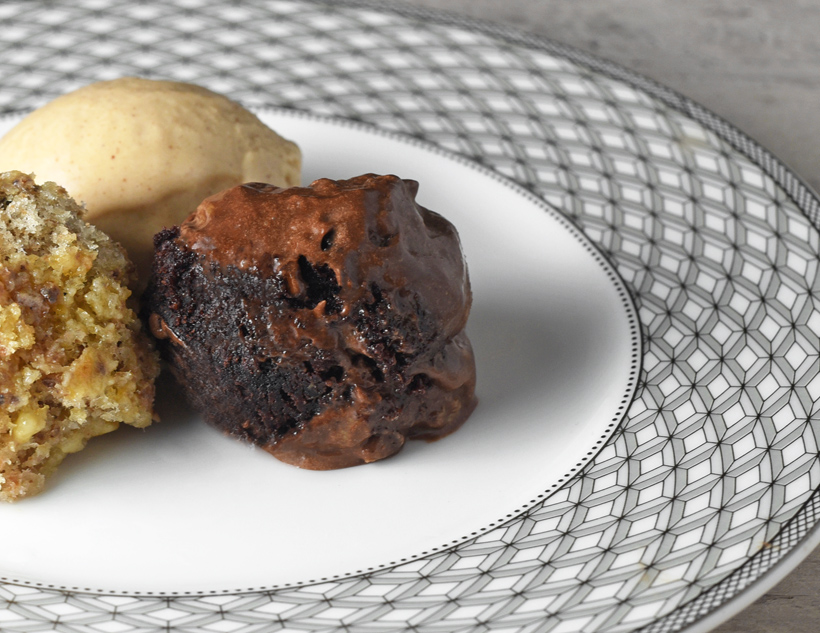
Apricot kernel ice cream
Yields about 10 servings
50 g apricot kernels
0.5 g salt
340 g milk
1.4 g ice cream stabilizer (optional)
30 g egg yolk
55 g superfine sugar
100 g heavy cream
20 g non-fat milk powder
50 g honey
- Place the apricot kernels on a sheet tray lined with parchment paper. Sprinkle with the salt, and cook in a 150 C / 300 F oven for 45 minutes.
- Bring half of the milk to a boil, and stir in the ice cream stabilizer (optional). Transfer to a blender with the toasted kernels, let steep for 5 minutes, then blend for at least 1 minute, until completely smooth. Pass through a chinois, and reserve.
- In a large bowl, whisk the egg yolks and sugar to a pale ribbon. Place the rest of the milk with the heavy cream, milk powder, and honey in a small saucepan and bring to a boil, stirring constantly. Pour into the bowl while whisking, add the apricot kernel and milk mixture, then place the bowl over a pot of simmering water, and whisk the custard until it reaches a temperature of 80 C / 175 F and coats the back of a spoon. Pass through a chinois into a container over a bowl of ice water, and let cool. Transfer the container to the freezer and wait until it is completely cold.
- Churn the custard in an ice cream maker, following the manufacturer’s instructions. Transfer to the freezer for at least 2 hours before serving.
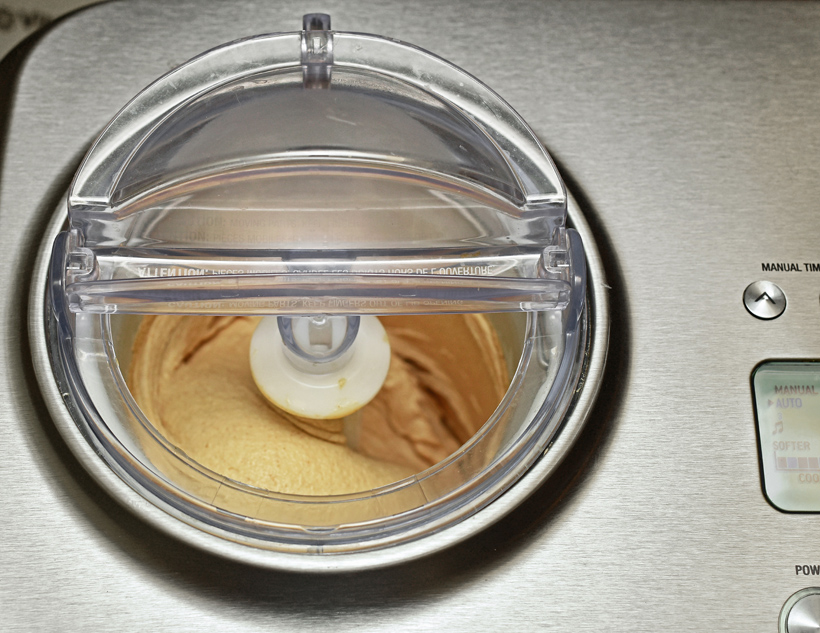
Apricot whipped cream
Yields about 10 servings
400 g heavy cream
0.4 g xanthan gum
40 g superfine sugar
15 g apricot brandy
- Pour the heavy cream into the bowl of an electric mixer fit with the whisk attachment, and start whisking on low speed.
- Add the xanthan gum, superfine sugar, and apricot brandy, then switch to high speed, and whip to hard peaks.
- Transfer to a piping bag fit with a decorating tip, and reserve in the refrigerator.
Assembly
Yields about 10 servings
apricot-walnut cake
chocolate-raisin cake
apricot kernel ice cream
apricot whipped cream
about 250 g chocolate-covered walnuts, coarsely chopped
- On each plate, using a #24 disher scoop (explanation here), arrange one scoop each of the apricot-walnut cake, chocolate-raisin cake, and apricot kernel ice cream.
- Pipe some whipped cream on top, and sprinkle with chocolate-covered walnuts. Serve immediately!


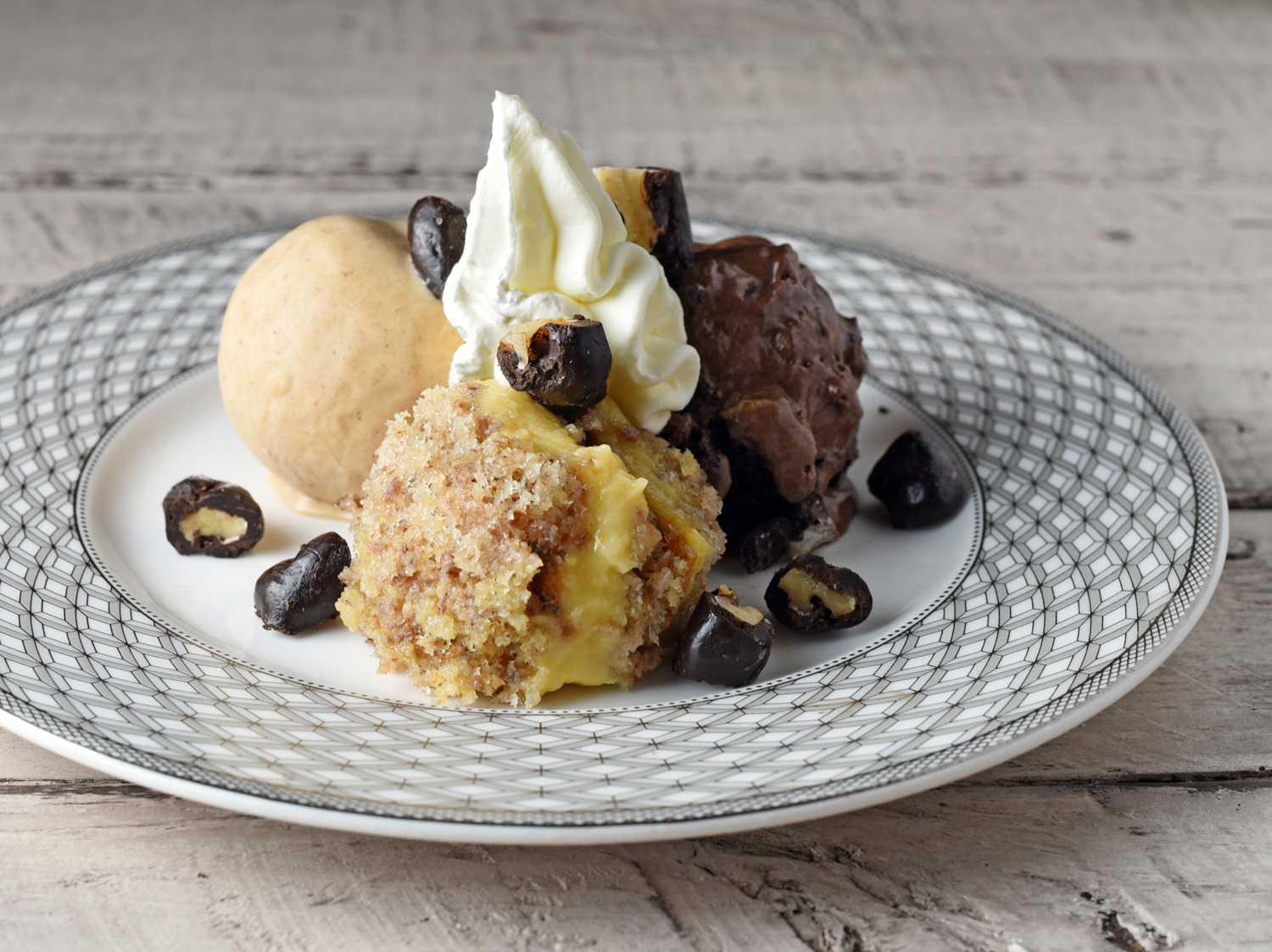
3 comments
I had a chance to sample it when I visited Budapest earlier this year. It was DELICIOUS! So glad to have the recipe now! Thank you 🙂
The first sentence I read is “You’ve probably never heard of Somlói galuska”. I looked it up without knowing how to spell it when I was reminded of it by a segment on Better Homes and Gardens about Hungarian dumplings. I had somloi galuska in 1976 when in Budapest and have never forgotten it. So pleased to now know what ingredients were in it and to have a recipe. Just need the health & energy and I will be able to try making it myself.
Thank you for re-thinking this classic recipe and for posting it. I had somloi galuska at Gerbeaud cafe 10 years ago and still remember its divine taste. While eating I expected taste and texture of soacked sponge cake, but sensed they used yeast dough for their somloi. I can be wrong of course, but since then I discovered recipes of: short cake pastry and cantucci with very small amount of yeast. In theory Gerbeaud’s pastry chef could use yeast. Wish I could learn more about their recipe, zero chances though.